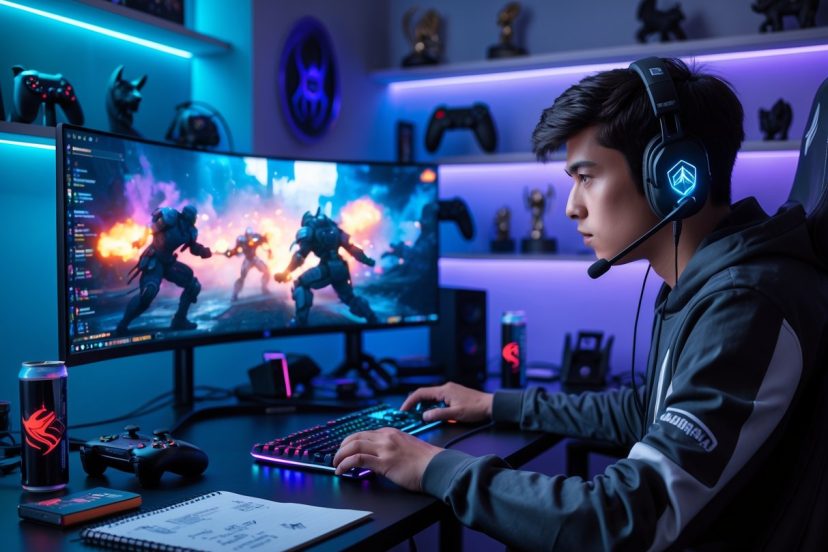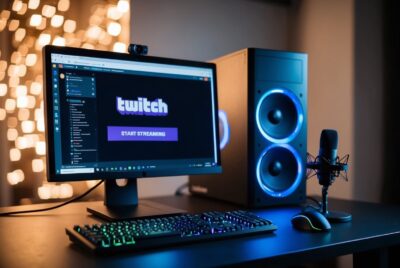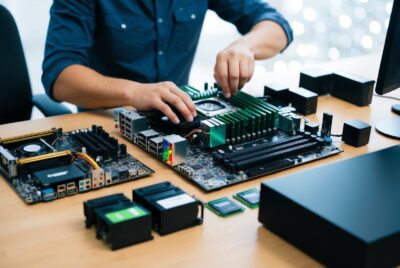How to Become a Pro Gamer
*We may earn a commission for purchases made using our links. Please see our disclosure to learn more.
How to Become a Pro Gamer Steps to Master Competitive Gaming
Becoming a pro gamer takes more than just loving video games—it requires skill, dedication, and the right mindset. To become a professional gamer, I need to choose a game to master, practice daily, join a team, and take part in tournaments. It is a competitive field, and not everyone will make it, but a focused approach can help me stand out.

I have to keep learning, work well with others, and take care of my health to stay at the top of my game. My journey is about steady improvement, patience, and always seeking ways to get better. This path is challenging, but with the right steps, I can work toward becoming a pro gamer.
Essential Skills and Game Mastery

To reach a professional level in gaming, I need to choose my game carefully, build in-depth knowledge of how it works, and learn advanced ways to outplay opponents. These areas form the core skills every pro gamer relies on.
Choosing Your Game Genre
Selecting the right game or genre is a major step. Not every game has an active esports scene. I look for titles with favorite tournaments, active pro teams, and a strong player base.
Genres like first-person shooters, battle royales, MOBAs, fighting games, and real-time strategy are typical paths. Each genre takes different abilities—shooters need fast reflexes, MOBAs need strong teamwork.
I also think about what games I enjoy and what fits my play style. Playing what I love helps me stay motivated. Researching which titles have sponsors, prize pools, and stable esports scenes helps me avoid dead-end games.
| Genre | Core Skills Needed | Example Games |
| Shooter | Aim, reflexes, tactics | CS2, Valorant |
| MOBA | Strategy, teamwork | League, Dota 2 |
Game Mechanics Expertise
Mastering the mechanics is key to improvement. I focus on every control, movement pattern, and character ability in my chosen game.
Knowing combos, optimal builds, and map layouts helps me react quickly under pressure. I set aside time daily for drills—like aim practice, timing jumps, or executing character moves.
I keep up with game updates and patch notes. This lets me adapt to changes and stay ahead of the competition. Watching top players or tutorials helps me pick up new tricks and sharpen my skills.
Grinding the basics and then moving to more complex mechanics gives me a solid foundation. I track my progress with replays or performance logs.
Advanced Strategies and Tactics
Learning advanced strategies separates casual gamers from pros. I make sure to understand not just what to do, but why to do it. This means thinking several moves ahead and anticipating how opponents will respond.
Analyzing past matches helps me spot patterns, mistakes, and chances to improve. I build my own strategies, then refine them by watching tournaments and scrims.
I practice team communication for games that require it. For solo-play games, I focus on mind games and prediction. Understanding meta shifts and counterplays lets me adapt quickly and find openings.
Key elements for strategy mastery:
- Map control and rotations
- Reading opponents
- Adapting to meta changes
- Efficient use of resources
By mastering these areas, I boost my chances at top-level play.
Building a Training Routine

To reach a professional level in gaming, I know I need a routine that balances practice, review, and personal health. Daily habits and discipline make a difference for skill growth and sustained motivation.
Practice Schedules
A consistent practice schedule is key for steady improvement. I set regular times each day to focus on specific skills, such as aiming, strategy, or teamwork. Scheduling practice helps me avoid burnout and make the most out of each session.
My typical training day might look like this:
| Time | Focus Area |
| 10:00–12:00 | Mechanics & Reflexes |
| 1:00–3:00 | Strategy & Team Play |
| 4:00–6:00 | Scrims or Ranked Games |
I break up long hours with short rests to stay focused. Keeping my sessions structured lets me work on weaknesses, set measurable goals, and gain the consistency needed at the pro level.
Analyzing Gameplay Footage
Watching my own matches helps me spot mistakes and learn from them. I record games and review key moments, looking at my decisions, map awareness, and reactions.
During review, I focus on:
- Positioning during fights
- Communication with teammates
- Timing for important actions
- Where I lost advantages
I also learn from watching top players. Pausing the footage and taking notes highlights strategies or tricks I can adopt. This routine is valuable because real progress comes from fixing errors, not just repeating them.
Physical and Mental Conditioning
Gaming at a high level requires both mental focus and physical health. I add short workouts and stretches to my daily routine to prevent stiffness and injuries, especially in my hands and wrists.
I pay attention to sleep and nutrition because lack of rest or poor diet affects my reaction time and decision-making. Deep breathing, short walks, and breaks away from screens help me clear my mind.
To handle stress, I practice mindfulness and set limits for screen time. Staying balanced is how I keep up intense training for the long term.
Competitive Play and Ranking Up

Reaching professional status in gaming means proving skill by consistently climbing ranked ladders, competing in key tournaments, and building relationships with other skilled players. I focus on practical actions that drive steady progress, help me gain recognition, and help me learn from leading competitors.
How To Become a Pro Gamer : Climbing the Ladder
I start by picking a game and mastering its mechanics. I play ranked modes because they place me against others with similar skill levels and offer clear feedback on my progress. I pay close attention to my ranking because it’s often what tournament scouts or teams look at first.
To improve, I regularly review my matches and note what I did right and where I made mistakes. I use training modes and watch top players to pick up strategies. I join online communities that discuss tips and meta changes for my game, helping me stay ahead of updates.
Climbing the ladder means playing daily, keeping a calm mindset even after losses, and learning from each experience. If my rank stalls, I set short-term goals, like reaching a certain tier within a month, so I stay motivated.
Participating in Tournaments
Competitive tournaments are where I test my abilities against top players and gain exposure in the community. I start with small online tournaments since these are easier to enter and less stressful than major events. As I build skill and confidence, I move to bigger local or regional events.
I keep track of tournament schedules through sites or apps that list upcoming events for my chosen game. Sometimes I play as part of a team, which teaches me teamwork and communication skills that are just as valuable as raw talent.
Preparing for a tournament means practicing specific maps, understanding rule sets, and watching past matches of likely opponents. I make sure to warm up before competing and keep my setup comfortable, as nerves can impact my performance.
Networking With Pro Players
Building connections with experienced players helps me learn about new opportunities and improves my skills through real feedback. I start by joining official game forums, Discord servers, and social media groups focused on my game.
When I find tournaments or ladders, I engage politely with others, ask questions, and offer help when I can. If I get the chance to play with or against a pro, I ask for advice if they seem open to it.
I also reach out to organizers of local events or streamers who are active in my game. Sometimes just showing up regularly and staying positive helps me get noticed. Having a solid network means I hear about team tryouts, practice groups, and new competitions early.
Setting Up Your Professional Environment

To perform at my best, I need both the right equipment and a good space for gaming. Having a reliable setup reduces distractions, prevents discomfort, and helps me stay focused during practice and tournaments.
How To Become a Pro Gamer : Optimizing Gaming Equipment
The first thing I look at is my main gaming device. That could be a PC or a console. I always choose hardware that meets or exceeds the minimum system requirements for the games I play. For a PC, I focus on a fast CPU, enough RAM (at least 16GB), and a powerful graphics card.
A good monitor is just as important. I use a high refresh rate screen (at least 144Hz) with a low response time (1ms or 2ms) for smoother visuals and faster reaction times. My keyboard and mouse are designed for gaming. I choose options that offer programmable keys, adjustable DPI, and ergonomic shapes to reduce hand fatigue.
A quality headset lets me hear in-game sounds and talk with teammates clearly. I make sure it’s comfortable and has a built-in microphone. I always use a stable wired internet connection to minimize lag.
Example Table: Minimum Equipment Checklist
| Equipment | Recommended Feature |
| PC/Console | Meets top specs |
| Monitor | 144Hz+, 1ms-2ms |
| Mouse & Keyboard | Gaming-grade, ergonomic |
| Headset | Quality audio, mic |
| Internet | Wired, low latency |
Creating a Productive Space
I set up my gaming area in a quiet room with good lighting. I use a sturdy desk that fits my equipment without being crowded. My chair is adjustable and supports my back, so I can play for long hours without pain.
I keep cables organized using clips or ties to avoid clutter and accidents. I always keep water nearby and make sure to have easy access to snacks, which helps me stay focused. I also add something personal to my space, like a poster or a small light, to keep the atmosphere positive.
When possible, I keep my gaming area separate from where I relax or sleep. This helps my brain associate the area with focus and performance. I ask family or housemates not to interrupt when I’m in the middle of a game or practice session. That way, I can give each session my full attention.
Monetizing and Managing Your Pro Gamer Career

Becoming a pro gamer requires more than just skill. Earning an income and building a stable career takes careful planning and effort in several areas.
How To Become a Pro Gamer : Joining Esports Teams
For me, joining an esports team is usually the first big step in a pro gaming career. Good teams offer salaries, paid travel, coaching, and access to top tournaments. To get on a team, I focus on excelling in ranked games and competing in online or local tournaments.
Most teams scout players who show consistent skill and teamwork. I keep my online scores and win rates high, and I make sure my public profile is active and positive. Showing respect to teammates and maintaining a good attitude help me stand out. After joining, my main tasks are practicing with my team, sharing strategies, and performing in matches.
Being part of a team also means handling contracts. I read contracts closely and ask questions about pay, obligations, and length of commitment. Some teams offer bonuses for big tournament wins or social media activity.
How To Become a Pro Gamer: Securing Sponsorships
Sponsorships are a key way I earn extra income outside of tournament winnings. Brands in gaming, tech, and energy drinks often look for pro gamers with active online followings. To attract sponsors, I build a strong presence on platforms like Twitch, YouTube, or X (formerly Twitter).
Sponsors value consistency, audience engagement, and professionalism. I always keep my content family-friendly and avoid controversies. When a sponsor reaches out, negotiations include payment, product promotion, and sometimes exclusive deals.
Typical sponsorship benefits for me include:
- Monthly payments
- Free or discounted gaming gear
- Paid shoutouts or branded live streams
It’s important to only work with brands I respect and products I actually use, to stay credible with fans.
Developing Your Personal Brand
Building a personal brand sets me apart from other gamers. My brand includes my gaming style, my personality, and the way I interact with followers. I pick a simple gamer tag, use a consistent logo, and have the same look across all my online profiles.
I post content regularly, including gameplay clips, tips, and behind-the-scenes looks at my training. Engaging with my audience is important; I answer questions, host Q&A sessions, and thank people for their support.
Staying authentic and positive helps me grow my brand over time. I also protect my reputation by avoiding toxic behavior and by following community guidelines on every platform I use.
Frequently Asked Questions
I often get questions about how to get started as a pro gamer, what earnings look like, and how to get noticed in the gaming scene. There are also many job paths in professional gaming and ways to build a strong online presence.
1. What steps should I take to start a career in professional gaming?
I start by picking a game that I enjoy and has a large esports community. I practice daily, join amateur competitions, and watch top players to learn strategies.
I connect with other gamers online, join teams, and get feedback. Attending local and online tournaments gives me experience and helps me get noticed.
2. What are the typical earnings for a professional gamer?
My income as a professional gamer can vary. Many gamers earn money from tournament prizes, team salaries, streaming, and sponsorships.
Most beginners may not earn much at first. Top players and streamers can make thousands or even millions of dollars a year, but this is less common.
3. At what age can one typically start playing games professionally?
Players often start playing competitively in their early teens. Many pro gamers enter tournaments at ages 16 to 18, since most major events have a minimum age requirement.
There is no strict upper age limit, but most pros begin young to build their skills early.
4. How can I improve my gaming skills to compete at a professional level?
Every day, I focus on practicing the game, studying strategies, and reviewing my gameplay to find mistakes. I watch professional matches, learn from better players, and work on teamwork if the game is team-based.
Physical and mental health is also important, so I make time for exercise, sleep, and breaks.
5. What are the job opportunities available in the professional gaming industry?
Besides playing as a pro, I can work as a coach, team manager, or streamer. There are jobs in event organizing, broadcasting, and creating gaming videos.
I might also find work in game testing, marketing, or social media for esports companies.




